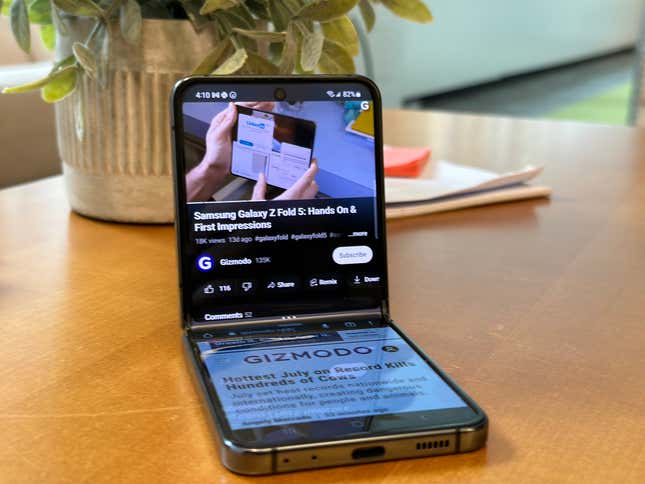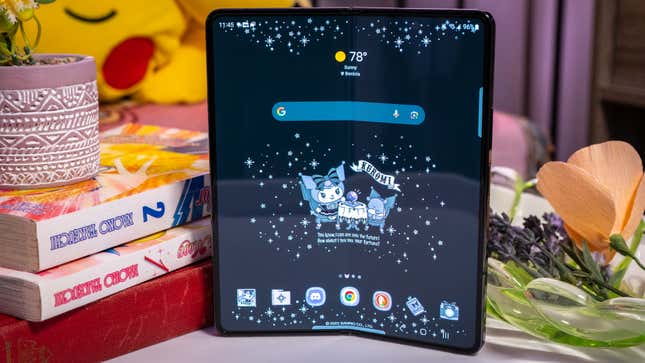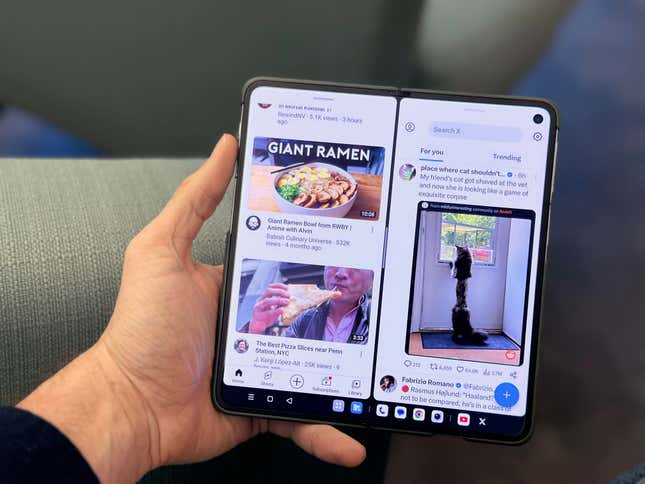Last year, I mused over whether foldable smartphones would ever be affordable. I wanted to see them take off after falling in love with the Galaxy Z Fold 4. This year, I got my answer. It’s a resounding “No,” especially with the foldable market as it is right now. Even with the recently launched Motorola Razr, a flip phone for under $800, the best foldables worth bringing home remain within that $1,800 pricepoint that Samsung set as the standard. It doesn’t seem like there’s any hope of a “budget” foldable—whatever that would look like—until more options are available.
At the very least, we’re on track for another era of new foldable, and this phone category is so much more exciting than it was a mere year ago. Every foldable launched in 2023 differed in its offerings—for example, the OnePlus Open and Google Pixel Fold offer varying aspect ratios. I still prefer the Galaxy Z Fold 5 because of Samsung’s cameras and software smarts, but as more Android apps become coded to work with the new form factor, the experience is improving across the platform. It’s a fun time not to be an iPhone user.
Flip phones and the hands that flip them
This year’s most prominent theme was that Samsung is no longer the only choice in foldables. Not only did we see book-like devices spawn among the top players in Android phones, but flip phones also propagated around the globe. It started early on with the Oppo Find N2 Flip in February, which we called in to preview what device manufacturers prioritize in other markets. Oppo doesn’t sell phones directly in the U.S., so we don’t usually cover them. But since it shares a parent company with OnePlus, Oppo devices are a fair indicator of trending features. The Find N2 Flip has a MediaTek Dimensity 9000+, up to 44w charging, and, most importantly, a 3.26-inch cover screen. That part of the device received the most accolades across the smartphone sphere.
Motorola followed with the Razr+ flip phone in the spring—the “plus” for the added front screen. The Razr+ boasts a Snapdragon 8+ Gen 1 chip, dual camera sensors, and a 3.6-inch pOLED exterior display. Motorola kept the phone within the $1,000 price range that Samsung had set as the benchmark with its Z Flip series. Reviewers liked the phone, and it received better scores than its predecessor.

Those larger cover screens on Oppo and Motorola’s respective devices resonated loudly. By the end of the summer, Samsung upgraded the Galaxy Z Flip 5 to a 3.4-inch screen from 1.9 inches in the previous generation. Finally, you could access more oft-used apps outside the main screen without prying open the phone.
Rumors about the Galaxy Z Flip 6 are scarce for now, but there is talk about what’s next from Oppo and the kind of precedent we’ll see set by the Find N Flip 4. (Oppo already launched the Find N3 Flip overseas.) Overall, the hope is that as these companies iterate on flip phones, you won’t have to make as many compromises—as you do with the one affordable flip phone launched this year.
The only affordable flip phone has a bad camera
We didn’t review this year’s Motorola Razr, but the professional reviewer consensus is that it’s a solid phone with one giant compromise. The primary camera on the $500 Razr is dismal—The Verge and Mr. Mobile think so. It also lacks water resistance for total immersion, which is generally fine but brings to mind the concessions you must make to cut costs.
The Razr also uses a Snapdragon chipset that’s over a year old. I could see a flip phone like this resonate on low-cost carriers for those who want to hop on the trend, but I wouldn’t suggest you choose this $500 phone over another one at an even lower cost—like the Pixel 7a—that’s more capable, durable, and proven to have a long lifespan.
Three folding phones are better than one

The year 2023 also saw more options in the book-like folding phone category. Google and OnePlus launched their respective takes, the Pixel Fold and the OnePlus Open. Both are impressive first attempts from both manufacturers, and you can see that each carries the flag of what each brand is about. For instance, the Pixel Fold showcases Google’s signature camera algorithms, while the OnePlus Open bundles in a whopping 16GB of memory—it’s known for going high RAM with its flagships.
My favorite book-like foldable this year was the Galaxy Z Fold 5. However, I’m also fully embedded in the Samsung ecosystem enough that switching to another Android maker would throw me off my game. My colleague, Kyle Barr, prefers the OnePlus Open and dubbed it the phone that “changed [his] mind” about foldables.
Android is the Baskin Robbins of the mobile world; there are dozens of flavors to choose from, but they don’t all share the same ingredients. OnePlus and Samsung’s foldables work because the software is explicitly tweaked to resonate with longtime users. Meanwhile, the Pixel Fold, a foldable made in Google’s image, focuses more on delivering the same camera algorithms marketed in the regular Pixel phone.

There is one bummer about the Z Fold 5 that I’m hoping gets addressed in the next generation. Samsung needs a better solution for the S Pen than a $100 case. The case is excellent for protecting the Fold from the elements, but the S Pen has a habit of falling out if it twists around too much in its holster. My kingdom for a Samsung Z Fold with the S Pen embedded inside the hinge!
Book-like foldables also struggle with balancing the scope of the front screen relative to the inside. While I still use the Galaxy Z Fold 5 daily for reading and scrolling TikTok, its narrow cover screen makes it hard to navigate with nails. I prefer the width of the Google Pixel Fold or even the OnePlus Open, though the issue with those is that the inside screen is too short and elongated for my liking. It’s a Goldilocks situation. You’ll have to find what’s “just right.”
2024’s Foldables
The upside of flip phones and foldables is that they’re all propagating on the Android platform. If you’re a foldable user, plenty of choices will come through as this trend continues, as long as you’re willing to fork over the cash and play the trade-up game every year when there’s an upgrade.
If you skipped out on them this year, start pinching your pennies for Samsung’s next-gen foldables in 2024. A wild rumor remains unverified—that a Galaxy Z Ultra will encompass all the Ultra can do with telescopic lenses. I’m simply holding out for the Z Fold to have a wider cover display.
There’s also a glimmer of hope that foldables will go beyond the middle hinge and roll instead. It’s more likely that 2024 will introduce the possibility, with actual devices still a few years out. Stick with us; we’ll cover the more believable rumors as they sprout in the new year.
Trending Products

Cooler Master MasterBox Q300L Micro-ATX Tower with Magnetic Design Dust Filter, Transparent Acrylic Side Panel, Adjustable I/O & Fully Ventilated Airflow, Black (MCB-Q300L-KANN-S00)

ASUS TUF Gaming GT301 ZAKU II Edition ATX mid-Tower Compact case with Tempered Glass Side Panel, Honeycomb Front Panel, 120mm Aura Addressable RGB Fan, Headphone Hanger,360mm Radiator, Gundam Edition

ASUS TUF Gaming GT501 Mid-Tower Computer Case for up to EATX Motherboards with USB 3.0 Front Panel Cases GT501/GRY/WITH Handle

be quiet! Pure Base 500DX ATX Mid Tower PC case | ARGB | 3 Pre-Installed Pure Wings 2 Fans | Tempered Glass Window | Black | BGW37

ASUS ROG Strix Helios GX601 White Edition RGB Mid-Tower Computer Case for ATX/EATX Motherboards with tempered glass, aluminum frame, GPU braces, 420mm radiator support and Aura Sync










